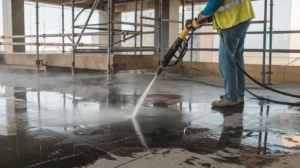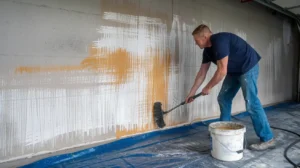Carrara and Calacatta marble are two of the most coveted natural stones in the world of interior design and architecture. Both originating from quarries in Italy, these marbles have distinct characteristics that set them apart. Understanding the differences between Carrara and Calacatta marble is crucial for anyone involved in selecting materials for construction or renovation projects. In this article, we’ll delve into the unique qualities of each type of marble, including their appearance, geological composition, availability, and typical applications.
Carrara vs Calacatta Marble| How Do They Look Different?

Color and Veining Patterns:
Carrara Marble: Carrara marble typically features a soft, grayish-white background color with subtle veining that ranges from light gray to blue-gray. The veins in Carrara marble are generally thin and linear, creating a delicate and elegant appearance.
Calacatta Marble: Calacatta marble is known for its bright white background color, often accompanied by thick, dramatic veining in shades of gray and gold. The veining in Calacatta marble tends to be more pronounced and can feature bolder patterns compared to Carrara marble.
Visual Comparison: When visually comparing Carrara and Calacatta marble, Carrara tends to have a softer and more understated appearance due to its lighter background color and thinner veining. In contrast, Calacatta marble exhibits a more striking and luxurious look with its bright white base and bold veining.
Texture and Appearance:
Surface Texture Differences: Both Carrara and Calacatta marble have a smooth and polished surface texture, typical of marble. However, Carrara marble may sometimes feature subtle variations in texture, such as small surface pitting or natural fissures, adding to its charm. Calacatta marble, on the other hand, tends to have a more uniform and pristine surface with fewer imperfections.
Reflectivity and Brightness Comparison: In terms of reflectivity and brightness, Calacatta marble often appears more luminous and reflective due to its bright white background color. Carrara marble, while still possessing a polished finish, may appear slightly less radiant in comparison, especially under certain lighting conditions.
How Different Lighting Affects Their Appearance: Both Carrara and Calacatta marble can exhibit varying appearances depending on the lighting conditions. Under natural sunlight or bright artificial lighting, the veining in Calacatta marble may appear more pronounced and dynamic, enhancing its dramatic appeal. Carrara marble, with its softer color palette and subtle veining, may exhibit a more muted and understated elegance in similar lighting environments. However, under low or indirect lighting, both marbles may appear more homogeneous in color and texture, with less pronounced veining.
Where Does Calacatta Marble Come From?
Origins of Calacatta Marble
Geological Formation: Calacatta marble is a type of high-quality marble that originates from Italy, specifically from the Apuan Alps in the Carrara region of Tuscany. It forms through the metamorphism of limestone under high pressure and temperature over millions of years.
Historical Significance: The Carrara region has a rich history of marble extraction dating back to ancient Roman times. Calacatta marble has been highly prized for its beauty and rarity for centuries, with its use in sculptures, monuments, and architectural masterpieces.
Quarries and Production
Main Regions where Calacatta Marble is Sourced: The primary quarries for Calacatta marble are located in the Carrara region of Tuscany, Italy. The mountainous terrain of this area contains veins of marble, including the sought-after Calacatta variety.
Extraction and Processing Techniques: Calacatta marble is extracted from quarries using a combination of traditional and modern techniques. Large blocks of marble are cut from the mountainside using diamond wire saws and then transported to processing facilities where they are cut into slabs, polished, and finished according to customer specifications.
Unique Characteristics
Notable Features Distinguishing Calacatta Marble: Calacatta marble is characterized by its white background and dramatic veining, which can range from subtle gray veins to bold, thick veins of gold or taupe. It is known for its luxurious appearance and high level of translucency, making it a popular choice for high-end architectural and interior design projects.
Famous Applications and Installations: Calacatta marble has been used in many iconic buildings and monuments around the world, including the Pantheon and Michelangelo’s David in Rome. It is also commonly found in upscale residential and commercial applications such as countertops, flooring, and wall cladding, adding a touch of elegance and sophistication to any space. If you want professional guidance then Stone Sealer Restoration is best in business.
Carrara vs Calacatta Marble Cost

Factors Influencing Cost
Quarry location and accessibility: The cost of marble can vary based on where it’s quarried and how easy it is to access the site. Transportation costs play a significant role in pricing.
Rarity and demand: Rarer types of marble or those in high demand will typically fetch higher prices due to their scarcity and popularity.
Quality and grade differences: Marble comes in various grades and qualities, ranging from commercial-grade to premium-grade, which affects its price.
Cost Comparison
Average price ranges for Carrara marble: Carrara marble, known for its grayish-white background with subtle veining, generally falls in the lower to mid-range price category compared to other types of marble. Prices can vary widely but typically range from $40 to $100 per square foot.
Average price ranges for Calacatta marble: Calacatta marble, prized for its white background with bolder and more dramatic veining, is considered more luxurious and tends to be more expensive marble. Prices for Calacatta marble can range from $100 to $250 per square foot or even higher, depending on the quality and rarity.
Factors that may cause price fluctuations: Market demand, availability of specific varieties, changes in extraction and transportation costs, and fluctuations in the economy can all influence the price of marble.
Considerations for Budget and Value
Balancing cost with desired aesthetics and quality: While Carrara marble may be more budget-friendly, Calacatta marble offers a more luxurious look. Consider your budget constraints alongside your desired aesthetic preferences and quality requirements.
Long-term investment perspective: Marble is a durable and timeless material that can add significant value to your property. While higher-quality marble may come with a higher upfront cost, it can also increase the resale value of your home and provide long-lasting beauty with proper care and maintenance. Therefore, it’s essential to view your marble purchase as a long-term investment.
Conclusion
Carrara and Calacatta marble, while both originating from Italy and sharing similarities in their luxurious appearance, exhibit distinct differences that make them unique choices for various design projects. Carrara marble typically features a softer, more subtle veining with a grayish background, lending a classic and timeless feel to spaces. On the other hand, Calacatta marble is renowned for its bold, dramatic veining patterns against a predominantly white backdrop, evoking a sense of opulence and grandeur. Feel free to contact us for any type of services or query like carrara vs calacatta marble.
FAQs
What Is The Primary Difference Between Carrara And Calacatta Marble?
Carrara marble typically features softer gray veins with a more subtle appearance, while Calacatta marble is known for its bold, thick veining and a whiter background.
Are There Variations Within Carrara And Calacatta Marble?
Yes, both Carrara and Calacatta marble can vary in appearance. Carrara marble can range from light to dark gray veining, while Calacatta marble can have different intensities of veining and coloration.
Which Marble Is More Expensive, Carrara Or Calacatta?
Generally, Calacatta marble is more expensive due to its rarity and distinct veining patterns.
Is One Marble More Suitable For Certain Applications Than The Other?
While both marbles are suitable for various applications such as countertops, flooring, and wall cladding, Calacatta marble is often chosen for high-end projects where a dramatic and luxurious look is desired.
Which Marble Is Easier To Maintain?
Both Carrara and Calacatta marble require similar maintenance, including regular sealing to protect against stains and etching. However, due to its lighter color, Carrara marble may show stains more visibly than Calacatta marble.
Our Services
Our Recent Post
How to Clean Concrete Floor | A Step-by-Step Guide for Sparkling Results
How to Clean Concrete Floor effectively is essential to maintaining...
Read MoreHow to Remove Paint from Concrete
How to Remove Paint from Concrete can be a challenging...
Read MoreTop 7 Popular Quartz Countertops Colors in 2024
Quartz countertops colors are at the forefront of modern interior...
Read MoreHow to Clean a Granite Composite Sink | Simple Steps for a Spotless Finish
How to Clean a Granite Composite Sink starts with understanding...
Read More








